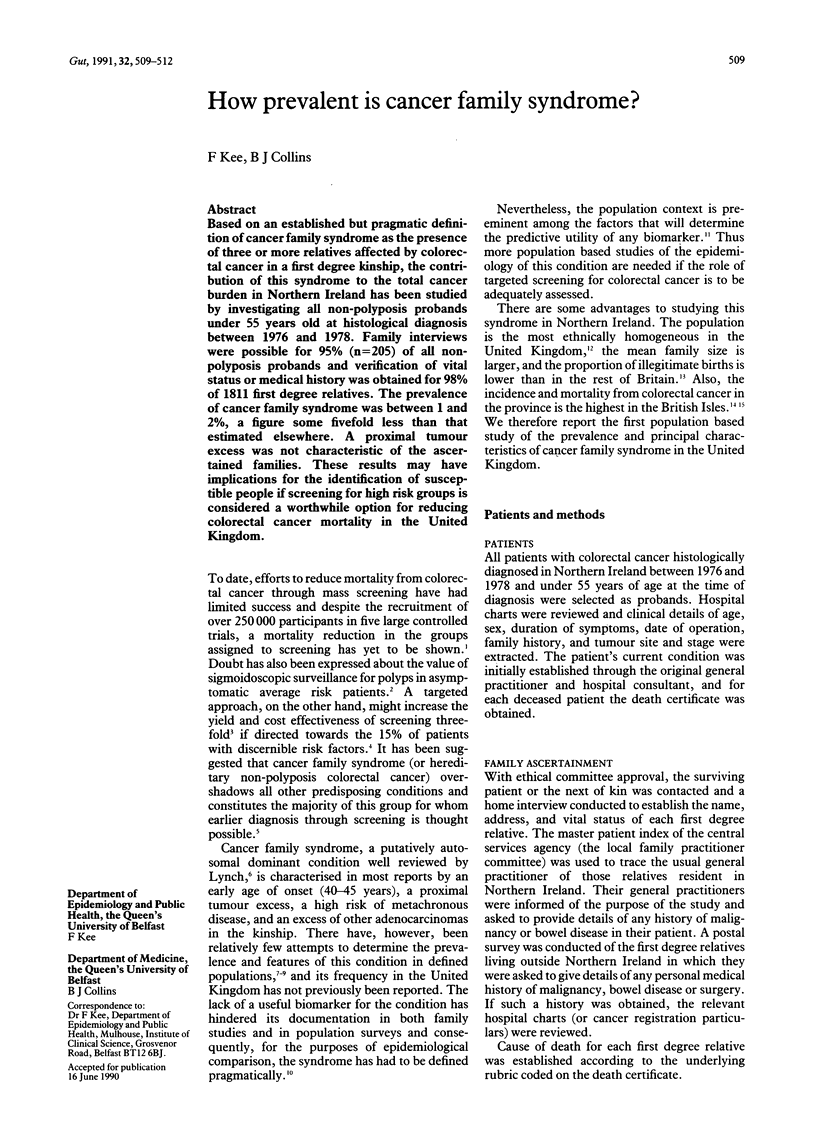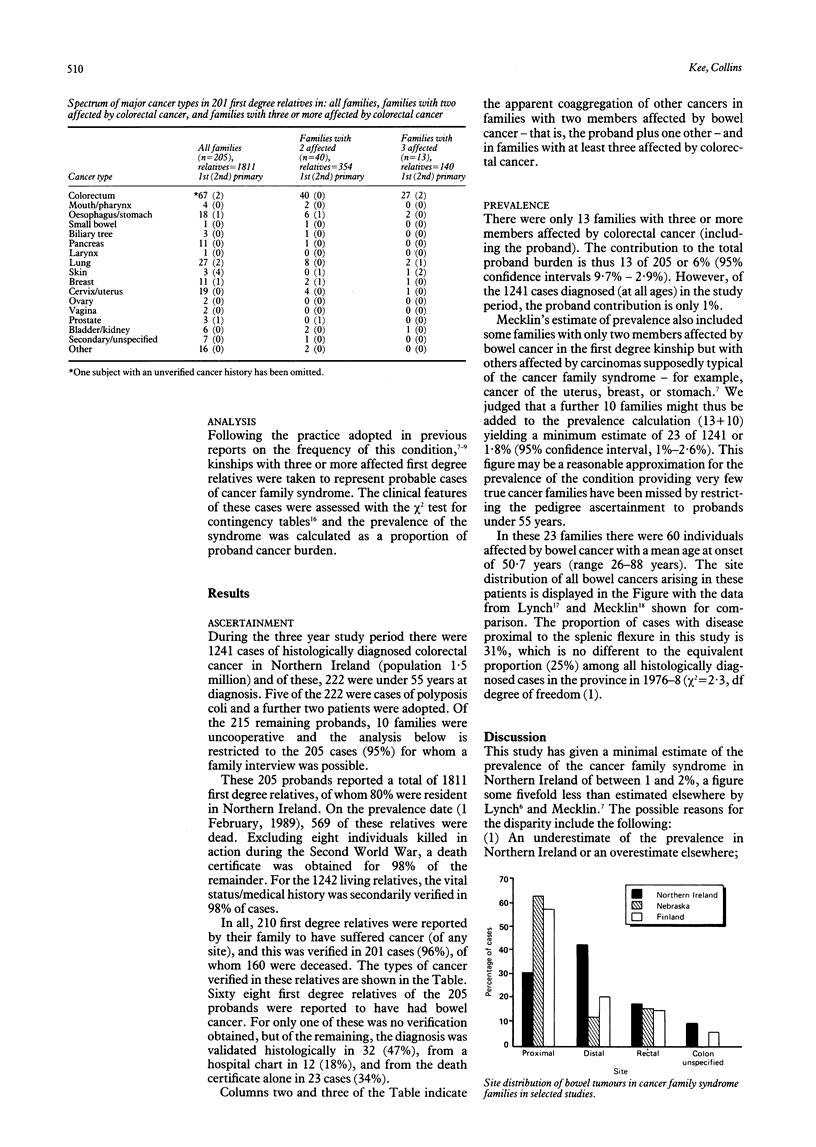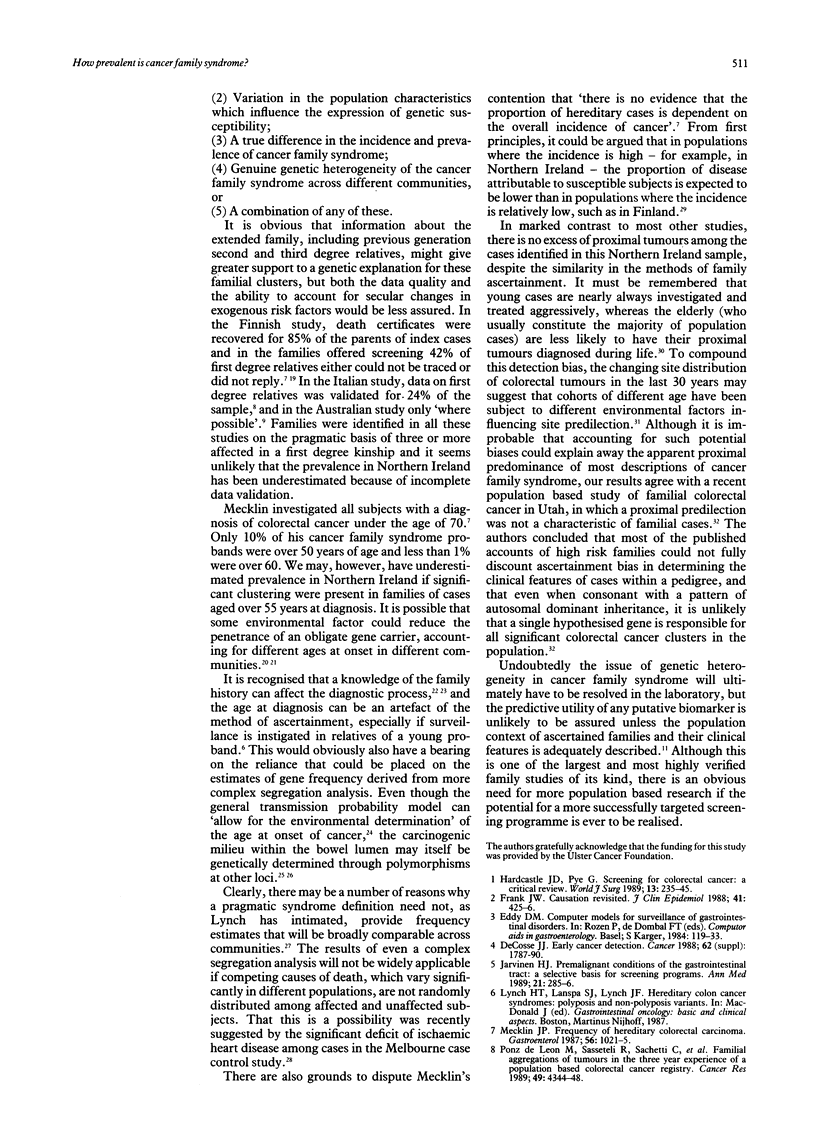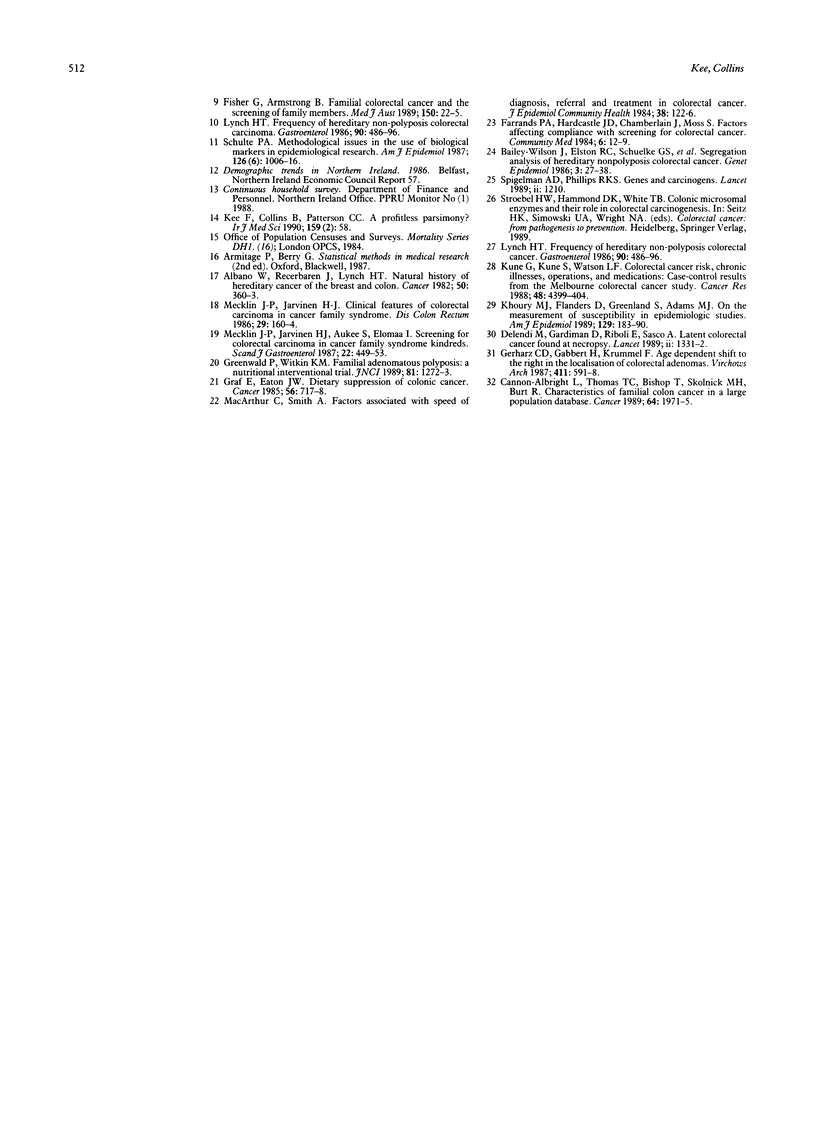Abstract
Based on an established but pragmatic definition of cancer family syndrome as the presence of three or more relatives affected by colorectal cancer in a first degree kinship, the contribution of this syndrome to the total cancer burden in Northern Ireland has been studied by investigating all non-polyposis probands under 55 years old at histological diagnosis between 1976 and 1978. Family interviews were possible for 95% (n = 205) of all non-polyposis probands and verification of vital status or medical history was obtained for 98% of 1811 first degree relatives. The prevalence of cancer family syndrome was between 1 and 2%, a figure some fivefold less than that estimated elsewhere. A proximal tumour excess was not characteristic of the ascertained families. These results may have implications for the identification of susceptible people if screening for high risk groups is considered a worthwhile option for reducing colorectal cancer mortality in the United Kingdom.
Full text
PDF



Selected References
These references are in PubMed. This may not be the complete list of references from this article.
- Albano W. A., Recabaren J. A., Lynch H. T., Campbell A. S., Mailliard J. A., Organ C. H., Lynch J. F., Kimberling W. J. Natural history of hereditary cancer of the breast and colon. Cancer. 1982 Jul 15;50(2):360–363. doi: 10.1002/1097-0142(19820715)50:2<360::aid-cncr2820500233>3.0.co;2-4. [DOI] [PubMed] [Google Scholar]
- Bailey-Wilson J. E., Elston R. C., Schuelke G. S., Kimberling W., Albano W., Lynch J. F., Lynch H. T. Segregation analysis of hereditary nonpolyposis colorectal cancer. Genet Epidemiol. 1986;3(1):27–38. doi: 10.1002/gepi.1370030104. [DOI] [PubMed] [Google Scholar]
- DeCosse J. J. Early cancer detection. Colorectal cancer. Cancer. 1988 Oct 15;62(8 Suppl):1787–1790. doi: 10.1002/1097-0142(19881015)62:1+<1787::aid-cncr2820621317>3.0.co;2-i. [DOI] [PubMed] [Google Scholar]
- Delendi M., Gardiman D., Riboli E., Sasco A. J. Latent colorectal cancer found at necropsy. Lancet. 1989 Jun 10;1(8650):1331–1332. doi: 10.1016/s0140-6736(89)92728-1. [DOI] [PubMed] [Google Scholar]
- Farrands P. A., Hardcastle J. D., Chamberlain J., Moss S. Factors affecting compliance with screening for colorectal cancer. Community Med. 1984 Feb;6(1):12–19. [PubMed] [Google Scholar]
- Fisher G., Armstrong B. Familial colorectal cancer and the screening of family members. Med J Aust. 1989 Jan 2;150(1):22–25. doi: 10.5694/j.1326-5377.1989.tb136314.x. [DOI] [PubMed] [Google Scholar]
- Frank J. W. Causation revisited. J Clin Epidemiol. 1988;41(5):425–426. doi: 10.1016/0895-4356(88)90042-x. [DOI] [PubMed] [Google Scholar]
- Gerharz C. D., Gabbert H., Krummel F. Age-dependent shift-to-the-right in the localization of colorectal adenomas. Virchows Arch A Pathol Anat Histopathol. 1987;411(6):591–598. doi: 10.1007/BF00713291. [DOI] [PubMed] [Google Scholar]
- Graf E., Eaton J. W. Dietary suppression of colonic cancer. Fiber or phytate? Cancer. 1985 Aug 15;56(4):717–718. doi: 10.1002/1097-0142(19850815)56:4<717::aid-cncr2820560402>3.0.co;2-4. [DOI] [PubMed] [Google Scholar]
- Greenwald P., Witkin K. M. Familial adenomatous polyposis: a nutritional intervention trial. J Natl Cancer Inst. 1989 Sep 6;81(17):1272–1273. doi: 10.1093/jnci/81.17.1272. [DOI] [PubMed] [Google Scholar]
- Järvinen H. J. Premalignant conditions of the gastrointestinal tract: a basis for selective screening programs. Ann Med. 1989 Aug;21(4):285–286. doi: 10.3109/07853898909149208. [DOI] [PubMed] [Google Scholar]
- Khoury M. J., Flanders W. D., Greenland S., Adams M. J. On the measurement of susceptibility in epidemiologic studies. Am J Epidemiol. 1989 Jan;129(1):183–190. doi: 10.1093/oxfordjournals.aje.a115107. [DOI] [PubMed] [Google Scholar]
- Kune G. A., Kune S., Watson L. F. Colorectal cancer risk, chronic illnesses, operations, and medications: case control results from the Melbourne Colorectal Cancer Study. Cancer Res. 1988 Aug 1;48(15):4399–4404. [PubMed] [Google Scholar]
- Lynch H. T. Frequency of hereditary nonpolyposis colorectal carcinoma (Lynch syndromes I and II). Gastroenterology. 1986 Feb;90(2):486–489. doi: 10.1016/0016-5085(86)90952-2. [DOI] [PubMed] [Google Scholar]
- Lynch H. T. Frequency of hereditary nonpolyposis colorectal carcinoma (Lynch syndromes I and II). Gastroenterology. 1986 Feb;90(2):486–489. doi: 10.1016/0016-5085(86)90952-2. [DOI] [PubMed] [Google Scholar]
- MacArthur C., Smith A. Factors associated with speed of diagnosis, referral, and treatment in colorectal cancer. J Epidemiol Community Health. 1984 Jun;38(2):122–126. doi: 10.1136/jech.38.2.122. [DOI] [PMC free article] [PubMed] [Google Scholar]
- Mecklin J. P. Frequency of hereditary colorectal carcinoma. Gastroenterology. 1987 Nov;93(5):1021–1025. doi: 10.1016/0016-5085(87)90565-8. [DOI] [PubMed] [Google Scholar]
- Mecklin J. P., Järvinen H. J., Aukee S., Elomaa I., Karjalainen K. Screening for colorectal carcinoma in cancer family syndrome kindreds. Scand J Gastroenterol. 1987 May;22(4):449–453. doi: 10.3109/00365528708991489. [DOI] [PubMed] [Google Scholar]
- Mecklin J. P., Järvinen H. J. Clinical features of colorectal carcinoma in cancer family syndrome. Dis Colon Rectum. 1986 Mar;29(3):160–164. doi: 10.1007/BF02555012. [DOI] [PubMed] [Google Scholar]
- Ponz de Leon M., Sassatelli R., Sacchetti C., Zanghieri G., Scalmati A., Roncucci L. Familial aggregation of tumors in the three-year experience of a population-based colorectal cancer registry. Cancer Res. 1989 Aug 1;49(15):4344–4348. [PubMed] [Google Scholar]
- Schulte P. A. Methodologic issues in the use of biologic markers in epidemiologic research. Am J Epidemiol. 1987 Dec;126(6):1006–1016. doi: 10.1093/oxfordjournals.aje.a114740. [DOI] [PubMed] [Google Scholar]
- Spigelman A. D., Phillips R. K., Venitt S. Genes and carcinogens. Lancet. 1989 Nov 18;2(8673):1210–1210. doi: 10.1016/s0140-6736(89)91810-2. [DOI] [PubMed] [Google Scholar]


